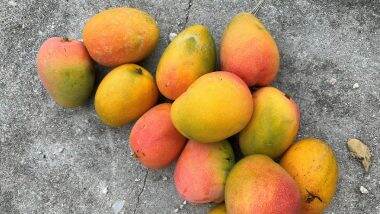Everyone's summer favourite, Mangoes, is not just the king of all fruits but are also laden with health benefits. Mangoes are well-known for providing the finest health outcomes when it is naturally ripened since they are rich in nutrients, minerals, and vitamins, as well as flavour and scent. FSSAI forbids the use of Calcium Carbide, a carcinogen, for artificial ripening due to the health risks it presents. The neurological system is known to be impacted by conditions like vertigo, drowsiness, mental fuzziness, and memory distortion. The hormonal system is further harmed by the traces of arsenic and phosphorous hydride.
The quality of the fruit significantly declines when calcium carbide is used; the fruit is excessively mushy, lacks the natural sweetness it may normally have, and rots more quickly than it would otherwise. Because the amount of calcium carbide in a product depends on how raw it is, its toxicity rises dramatically. Mangoes and Their Names: This Mango Season in India, Here's a Selection of Delightful Varieties for You.
What are the harmful effects of Calcium Carbide used for artificially ripening mangoes?
There are some sellers who use unripe mangoes and then artificially ripen them using calcium carbide, which is technically known as calcium carbide (CaC2). Certain mango sellers want to shorten the cycle of mango ripening, which is of about 8 to 10 days before it reaches you to earn more. The government, however, forbids and has made it unlawful to use calcium carbide on mangoes because it can cause cancer.
What is Calcium Carbide?
Calcium Carbide, which is extremely detrimental to human health, is prohibited by the FDA under the FSSR 2011 and FSSA 2006. We should avoid eating mangoes that have been ripened with carbide because calcium is a carcinogenic substance that is extremely toxic for humans and may cause cancer. According to physicians, these mangoes are severely prohibited due to their potentially highly hazardous medical consequences on humans.
There are a few ways to figure out artificially ripened mangoes:
1. Verify the colour
Mangoes that have been chemically ripened may have a surface that is a blend of yellow and green colours, with the green standing out from the yellow in places. On the other hand, it will be a consistent mixture of green and yellow in organically matured mangoes.
2. Juicy or not
Mangoes that haven't been chemically ripened will be luscious instead of having very little juice within.
3. Sample it
When you eat a mango that has been artificially ripened, your taste buds will experience a small burning sensation. People may occasionally develop stomach pain, diarrhoea, and throat burning.
4. Water Test
Mangoes should be placed in a bucket of water. Mangoes that have ripened naturally sink. They are artificially harvested if they float. A mango that has been artificially ripened will also have little to no liquid spilling from it. Having a mango that has been unnaturally picked may even cause burns.
Remember that mangoes that have naturally matured weigh more and more while maintaining precise wetness.
(The above story first appeared on LatestLY on May 05, 2023 02:11 PM IST. For more news and updates on politics, world, sports, entertainment and lifestyle, log on to our website latestly.com).













 Quickly
Quickly





















